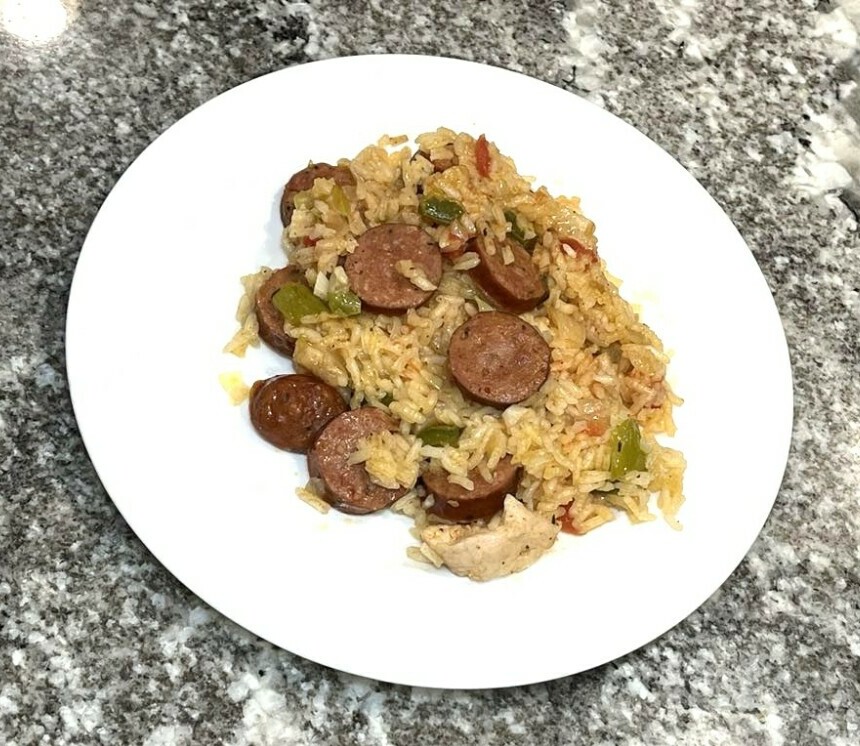Josh’s Spicy Jambalaya

What’s a celebrated rice dish with deep American roots – jambalaya. Waves of European settlers, West African slaves, and Caribbean migrants have weaved their ingredients and traditions into this hearty meal, turning it into a staple of Louisiana’s culinary scene. The birthplace of jambalaya, Louisiana, was a cultural melting pot where Spanish and French influences fused with local Native American food practices.
If you want to understand the origins of jambalaya, you have to consider the Spanish quest for their beloved paella in the New World. Upon settling in Louisiana, the Spanish realized that saffron, a key ingredient for paella, was not readily available. They adapted using native ingredients and what was available, which laid the first stones for what would become jambalaya.
The French touch came with the arrival of the Acadians, who brought their culinary practices to Louisiana’s bayou. They blended their knowledge of cooking hearty stews with local resources, contributing to the foundation of jambalaya as we know it.
Jambalaya is not just about European flavors, though. Enslaved Africans brought knowledge of native grains, introducing rice as a staple and changing the culinary landscape. The dish also absorbed the vibrancy of Caribbean spices, further shaping its bold and diverse profile.
Given this intricate mix, jambalaya naturally reflects the diverse history of the South, a story of adaptation, survival, and cultural exchange. It’s also an example of how food evolves over time, absorbing the saga of its people into every bite.
Celebrating Jambalaya: Festivals and Events
You’re going to find out about how Jambalaya is much more than a mere item on a menu; it’s a cultural phenomenon. Across Louisiana and beyond, communities come together to celebrate Jambalaya through various festivals and events. In Gonzales, Louisiana, the Jambalaya Festival draws thousands every year with its Jambalaya cooking contests, signaling the importance of Jambalaya craftsmanship and family recipes passed through generations.
I’m here to help you understand that these celebrations aren’t just about eating good food. They’re about heritage and local pride. Picture the scene at a Jambalaya festival: live music fills the air, pots bubble with aromatic spices, and chefs compete to see who has the ‘best Jambalaya in town.’ It’s an experience that engages all senses and brings people together.
Don’t worry too much about getting your Jambalaya recipe perfect. Festivals often include cooking demonstrations where you can learn from seasoned pros. Choose something that resonates with you – whether that’s a traditional Creole Jambalaya, the spicier Cajun version, or something entirely new inspired by the melting pot of Jambalaya influences.
A lot is happening very quickly at these events, but that’s the strategy I like to leverage: take it all in. Watch the experienced cooks, ask questions, and immerse yourself in the cooking process. Your first attempt doesn’t need to be your last. In fact, just don’t focus too much on perfection; it’s the learning and celebrating that count.
I really hope that you take the opportunity to dive into the vibrant world of Jambalaya festivals. Understanding its cultural significance and witnessing the love and competition that go into crafting the perfect pot can deepen your appreciation for this hearty dish. So next time you enjoy Jambalaya, remember it’s about the storied journey it’s been on – one that continues to evolve and weave new stories into its rich tapestry.
Ingredients
- 1 large onion diced
- 2 celery stocks sliced
- 1/2 bell pepper cored, seeded, and diced
- 3 jalapeños cored, seeded, and diced
- 3 garlic gloved minced
- 1 chicken breast diced
- 1 to 2, andouille sausages
- 1/4 cup ghee
- 1/4 tsp thyme
- 1/2 tbsp creole seasoning
- 1/2 tsp cayenne pepper
- 1/2 15 oz can of diced tomatoes (fire roasted works too)
- 1 1/2 cups long grain rice
- 2 cup of chicken broth, more as needed
-
Directions
- Add ghee to heated pan (over medium heat)
- Add onion, celery, bell pepper, and jalapeño to pan and cook about 5 minutes until onion is translucent
- Add thyme, creole seasoning, and cayenne pepper to pan and mix around
- Add garlic and cook about 3 minutes
- Add chicken breast and cook about 5 minutes
- Add andouille sausage and cook another 5 minutes
- Add half can of diced tomatoes with juices and mix around about a minute or so
- Add rice, and cook rice in pan about 2 to 3 minutes
- Add chicken broth to pan, make sure all rice is submerged into broth
- Reduce heat to low, cover with lid, and simmer 30 to 40 minutes or until rice is done
Enjoy! Don’t catch on fire.
Serves 4 to 6
